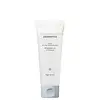What's inside
What's inside
 Key Ingredients
Key Ingredients

 Benefits
Benefits

 Concerns
Concerns

 Ingredients Side-by-side
Ingredients Side-by-side

Aloe Barbadensis Leaf Extract
EmollientWater
Skin ConditioningSodium Methyl Oleoyl Taurate
CleansingLauryl Glucoside
CleansingGlycerin
HumectantSodium Chloride
MaskingPanthenol
Skin ConditioningSodium Olivate
CleansingChamaecyparis Obtusa Leaf Extract
Skin ConditioningRosa Rugosa Leaf Extract
HumectantCitric Acid
BufferingMelissa Officinalis Leaf Extract
Skin ConditioningSodium Sweetalmondamphoacetate
Cleansing1,2-Hexanediol
Skin ConditioningDisodium EDTA
Papain
Skin ConditioningSodium Hyaluronate
HumectantMaltodextrin
AbsorbentPropanediol
SolventSodium Hyaluronate Crosspolymer
HumectantHydrolyzed Glycosaminoglycans
HumectantBenzyl Glycol
SolventHydrolyzed Hyaluronic Acid
HumectantEthylhexylglycerin
Skin ConditioningHyaluronic Acid
HumectantRaspberry Ketone
MaskingAloe Barbadensis Leaf Extract, Water, Sodium Methyl Oleoyl Taurate, Lauryl Glucoside, Glycerin, Sodium Chloride, Panthenol, Sodium Olivate, Chamaecyparis Obtusa Leaf Extract, Rosa Rugosa Leaf Extract, Citric Acid, Melissa Officinalis Leaf Extract, Sodium Sweetalmondamphoacetate, 1,2-Hexanediol, Disodium EDTA, Papain, Sodium Hyaluronate, Maltodextrin, Propanediol, Sodium Hyaluronate Crosspolymer, Hydrolyzed Glycosaminoglycans, Benzyl Glycol, Hydrolyzed Hyaluronic Acid, Ethylhexylglycerin, Hyaluronic Acid, Raspberry Ketone
Aloe Barbadensis Leaf Extract 74.44%
EmollientCitrus Junos Fruit Extract 10%
Skin ConditioningCentella Asiatica Extract 5%
CleansingVitis Vinifera Seed Oil 2%
EmollientOlea Europaea Fruit Oil 2%
MaskingCetearyl Olivate
Sorbitan Olivate
EmulsifyingStearic Acid
CleansingCetyl Alcohol
EmollientButyrospermum Parkii Butter 0.5%
Skin ConditioningPrunus Armeniaca Kernel Oil 0.5%
MaskingOenothera Biennis Oil 0.5%
EmollientAstrocaryum Murumuru Seed Butter 0.2%
EmollientGluconolactone
Skin ConditioningHyaluronic Acid
HumectantSalix Alba Bark Extract
AstringentSaccharum Officinarum Extract
MoisturisingHippophae Rhamnoides Fruit Oil 0.01%
Skin ProtectingCucurbita Pepo Seed Oil 0.01%
EmollientLactobacillus 0.01%
Skin ConditioningBetaine
HumectantCapsicum Annuum Fruit Extract
AntimicrobialScutellaria Baicalensis Root Extract
AstringentPaeonia Suffruticosa Root Extract
Skin ProtectingGlycyrrhiza Glabra Root Extract
BleachingXanthan Gum
EmulsifyingAniba Rosodora Wood Oil
AstringentCitrus Aurantium Bergamia Fruit Oil
MaskingCitrus Aurantium Dulcis Oil
MaskingCitrus Junos Peel Oil
AstringentLinalool
PerfumingLimonene
PerfumingAloe Barbadensis Leaf Extract 74.44%, Citrus Junos Fruit Extract 10%, Centella Asiatica Extract 5%, Vitis Vinifera Seed Oil 2%, Olea Europaea Fruit Oil 2%, Cetearyl Olivate, Sorbitan Olivate, Stearic Acid, Cetyl Alcohol, Butyrospermum Parkii Butter 0.5%, Prunus Armeniaca Kernel Oil 0.5%, Oenothera Biennis Oil 0.5%, Astrocaryum Murumuru Seed Butter 0.2%, Gluconolactone, Hyaluronic Acid, Salix Alba Bark Extract, Saccharum Officinarum Extract, Hippophae Rhamnoides Fruit Oil 0.01%, Cucurbita Pepo Seed Oil 0.01%, Lactobacillus 0.01%, Betaine, Capsicum Annuum Fruit Extract, Scutellaria Baicalensis Root Extract, Paeonia Suffruticosa Root Extract, Glycyrrhiza Glabra Root Extract, Xanthan Gum, Aniba Rosodora Wood Oil, Citrus Aurantium Bergamia Fruit Oil, Citrus Aurantium Dulcis Oil, Citrus Junos Peel Oil, Linalool, Limonene
Ingredients Explained
These ingredients are found in both products.
Ingredients higher up in an ingredient list are typically present in a larger amount.
Aloe Barbadensis Leaf Extract is an extract of the leaves of the aloe, Aloe barbadensis, Liliaceae.
Aloe is one of the most well-known natural soothing ingredients, and for good reason. It’s full of water and has a cooling, calming effect on the skin, especially when it’s sunburned, itchy, or irritated. Aloe also helps your skin stay hydrated and smooth by mimicking what healthy skin naturally produces. On top of that, it contains vitamins and nutrients that support skin recovery.
It doesn’t protect you from the sun, but it can help your skin bounce back after too much time in it.
Let’s get into the details:
Aloe contains antioxidant Vitamins A, C, and E, which help fight off free radicals (unstable molecules from things like pollution that can damage your skin).
It’s also rich in polysaccharides, which are natural sugars that help hydrate the skin by acting like the skin’s own moisturizing agents. These, along with other sugars like monosaccharides, help form a protective barrier that locks in moisture.
Aloe works as both a humectant and an emollient. That means it draws water into the skin (humectant) and helps trap it there (emollient), making it an effective natural moisturizer.
You’ll also find a mix of other skin-supporting ingredients in aloe, including folic acid, choline, calcium, amino acids, fatty acids, and even Vitamin B12.
Out of the 420+ species of aloe, Aloe barbadensis is the most widely used in skincare products thanks to its gentle yet effective properties.
There are over 420 species of aloe but Aloe Barbadensis is the most commonly used for topical products.
Learn more about Aloe Barbadensis Leaf ExtractHyaluronic acid is naturally found in healthy skin. It is a humectant, meaning it draws moisture to your skin.
This ingredient helps hydrate, soothe, and protect the skin.
What makes hyaluronic acid so hydrating? It has the capacity to bind or hold large amounts of water.
Fun fact: It is already naturally found in our bodies, such as the fluids of our eyes and our joints.
Studies find this ingredient to have anti-inflammatory and anti-microbial properties. This can help speed up wound-healing.
Hyaluronic acid can be irritating if the molecule has a low-molecular weight, or if the molecules are small.
One study found low-molecular weight hyaluronic acid to be pro-inflammatory, meaning some people may experience irritation. This is because our bodies use hyaluronic acid in the wound-healing process to signal to our bodies, via irritation, that something needs healing.
The same study found high-molecular weight hyaluronic acid to be anti-inflammatory.
These are some other common types of Hyaluronic Acid:
Learn more about Hyaluronic Acid